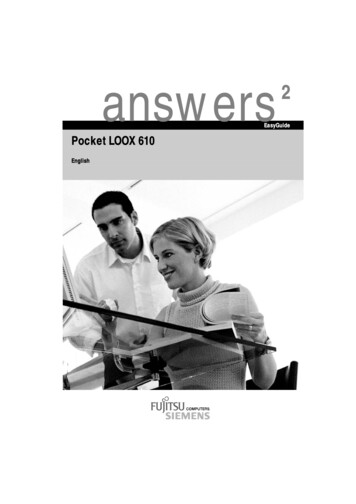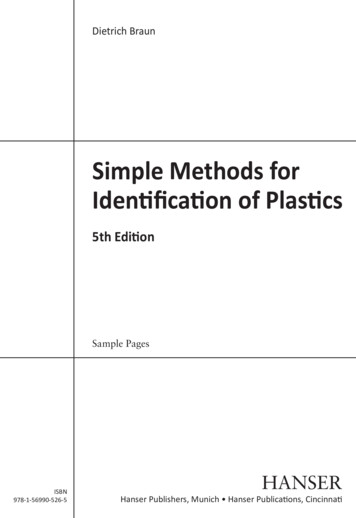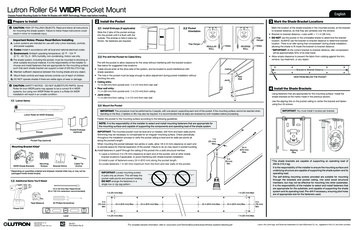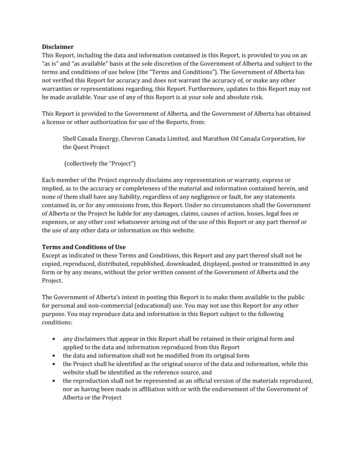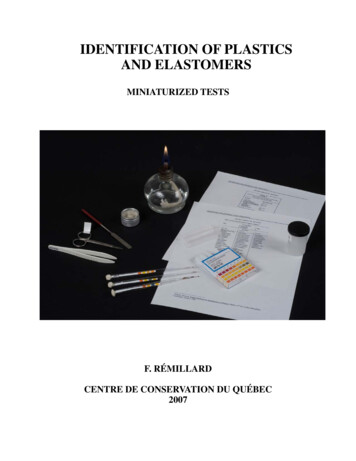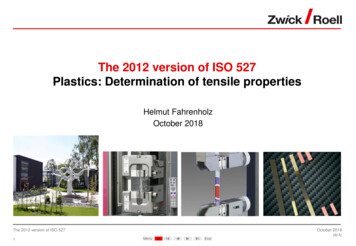
Transcription
Plastics Pocket PowerRaoDiagnostics ofExtrusionProcesses
Pocket PowerNatti S. RaoDiagnostics ofExtrusion ProcessesHANSERHanser Publications, Cincinnati Hanser Publishers, Munich
Distributed in North and South America by:Hanser Publications6915 Valley Avenue, Cincinnati, Ohio 45244-3029, USAFax: (513) 527-8801Phone: (513) 527-8977www.hanserpublications.comDistributed in all other countries byCarl Hanser VerlagPostfach 86 04 20, 81631 Munich, GermanyFax: 49 (89) 98 48 09www.hanser-fachbuch.deThe use of general descriptive names, trademarks, etc., in this publication,even if the former are not especially identified, is not to be taken as a sign thatsuch names, as understood by the Trade Marks and Merchandise Marks Act,may accordingly be used freely by anyone. While the advice and informationin this book are believed to be true and accurate at the date of going to press,neither the author nor the editors nor the publisher can accept any legalresponsibility for any errors or omissions that may be made. The publishermakes no warranty, express or implied, with respect to the material containedherein.Cataloging-in-Publication Data is on file with the Library of CongressISBN 978-1-56990-568-5E-Book-ISBN 978-1-56990-569-2Bibliografische Information Der Deutschen BibliothekDie Deutsche Bibliothek verzeichnet diese Publikation in der DeutschenNationalbibliografie; detaillierte bibliografische Daten sind im Internet über http://dnb.d-nb.de abrufbar.All rights reserved. No part of this book may be reproduced or transmitted inany form or by any means, electronic or mechanical, including photocopyingor by any information storage and retrieval system, without permission inwriting from the publisher. Carl Hanser Verlag, Munich 2014Production Management: Steffen JörgCoverdesign: Stephan RönigkTypesetted, printed and bound by Kösel, KrugzellPrinted in Germany
3Table of ContentsPreface . . . . . . . . . . . . . . . . . . . . . . . . . . . . . . . . . . . . . . .17Rheological Properties of Molten Polymers . .111.1 Polymer Melt Flow . . . . . . . . . . . . . . . . . . . . . . . . . .1.1.1 Apparent Shear Rate . . . . . . . . . . . . . . . . . . . . . .1.1.2 Apparent Viscosity . . . . . . . . . . . . . . . . . . . . . . .1.1.3 Power Law of Ostwald and de Waele . . . . . . . . . .1.1.4 Viscosity Formula of Klein . . . . . . . . . . . . . . . . .111213141617191.1.5 Resin Characterization by Power Law Exponent1.1.6 Melt Flow Index . . . . . . . . . . . . . . . . . . . . . . . . .1.2 Relationship between Flow Rate andPressure Drop . . . . . . . . . . . . . . . . . . . . . . . . . . . . . .201.3 Shear Rates for Extrusion Dies . . . . . . . . . . . . . . . .222Analytical Procedures for TroubleshootingExtrusion Screws . . . . . . . . . . . . . . . . . . . . . . . . . .2.1 Three-Zone Screw . . . . . . . . . . . . . . . . . . . . . . . . . .2.1.1 Extruder Output . . . . . . . . . . . . . . . . . . . . . . . . .2.1.2 Feed Zone . . . . . . . . . . . . . . . . . . . . . . . . . . . . .2.1.3 Metering Zone (Melt Zone) . . . . . . . . . . . . . . . .2.1.4 Practical Evaluation of Screw Geometry . . . . . . .2.2 Melting of Solids as a Tool for SolvingScrew Problems . . . . . . . . . . . . . . . . . . . . . . . . . . . .2.2.1 Obtaining Better Melt Quality . . . . . . . . . . . . . .2728293032333939
43Table of ContentsInvestigating Die Performance andDie Design by Computational Tools . . . . . . . . .493.1 Spider Dies . . . . . . . . . . . . . . . . . . . . . . . . . . . . . . . .3.1.1 Pressure Drop along the Spider . . . . . . . . . . . . . .3.2 Spiral Dies . . . . . . . . . . . . . . . . . . . . . . . . . . . . . . . . .4950533.2.1 Problem Solving by Simulating Shear Rateand Pressure . . . . . . . . . . . . . . . . . . . . . . . . . . . .3.3 Adapting Die Design to Avoid Melt Fracture . . . .3.3.1 Pelletizer Dies . . . . . . . . . . . . . . . . . . . . . . . . . . .3.3.2 Blow Molding Dies . . . . . . . . . . . . . . . . . . . . . . .3.3.3 Summary of the Die Design Procedures . . . . . . .3.4 Flat Dies . . . . . . . . . . . . . . . . . . . . . . . . . . . . . . . . . .5356565658593.5 An Easily Applicable Method of DesigningScreen Packs for Extruders . . . . . . . . . . . . . . . . . . .3.5.1 Mesh Size . . . . . . . . . . . . . . . . . . . . . . . . . . . . . .3.5.2 Design Procedure . . . . . . . . . . . . . . . . . . . . . . . .3.5.3 Influence of Polymer Type and Screen Blocking .636365674Parametrical Studies . . . . . . . . . . . . . . . . . . . . . .734.1 Blown Film . . . . . . . . . . . . . . . . . . . . . . . . . . . . . . . .735Design Software . . . . . . . . . . . . . . . . . . . . . . . . . .795.1 Input and Output Data . . . . . . . . . . . . . . . . . . . . . .5.1.1 VISRHEO . . . . . . . . . . . . . . . . . . . . . . . . . . . . .5.1.2 TEMPMELT . . . . . . . . . . . . . . . . . . . . . . . . . . . .808183
Table of Contents65Thermal Properties of Solid andMolten Polymers . . . . . . . . . . . . . . . . . . . . . . . . . .896.16.26.36.46.56.66.76.86.9Specific Volume . . . . . . . . . . . . . . . . . . . . . . . . . . . .Specific Heat . . . . . . . . . . . . . . . . . . . . . . . . . . . . . . .Thermal Expansion Coefficient . . . . . . . . . . . . . . .Enthalpy . . . . . . . . . . . . . . . . . . . . . . . . . . . . . . . . . .Thermal Conductivity . . . . . . . . . . . . . . . . . . . . . . .Thermal Diffusivity . . . . . . . . . . . . . . . . . . . . . . . . .Coefficient of Heat Penetration . . . . . . . . . . . . . . .Heat Deflection Temperature . . . . . . . . . . . . . . . .Vicat Softening Point . . . . . . . . . . . . . . . . . . . . . . .89939597981001031041067Heat Transfer in Plastics Processing . . . . . . . . .1097.1 Case Study: Analyzing Air Gap Dynamics inExtrusion Coating by Means of DimensionalAnalysis . . . . . . . . . . . . . . . . . . . . . . . . . . . . . . . . . . .1097.1.1 Heat Transfer between the Film and theSurrounding Air . . . . . . . . . . . . . . . . . . . . . . . .7.1.2 Chemical Kinetics . . . . . . . . . . . . . . . . . . . . . . . .7.1.3 Evaluation of the Experiments . . . . . . . . . . . . . .111113114References . . . . . . . . . . . . . . . . . . . . . . . . . . . . . . . . . . . .117Index . . . . . . . . . . . . . . . . . . . . . . . . . . . . . . . . . . . . . . . . .121
7PrefaceThe plastics engineer working on the shop floor of anindustry that manufactures blown film, blow-molded articles, or injection-molded parts, to name a few processes,often needs quick answers to questions, such as why extruderoutput is lower than expected, whether changing the resinwill produce a better quality product, or how to estimate thepressure drop in the die. Numerical analysis to address thesekinds of issues is time-consuming and costly, and requirestrained personnel. As experience shows, most of these issuescan be addressed quickly by applying proven, practical calculation procedures that can be performed by pocket calculators, and therefore can be handled on the site where themachines are running.This book is an abridged version of the same topic treatedin Understanding Plastics Engineering Calculations by Natti S.Rao and Nick R. Schott. Yet in this compact format it has allthe features of the original work and can be used, not only forestimating the effect of design and process parameters on theproduct quality, but also for troubleshooting practical problems encountered in the field of polymer processing by extrusion. This book is intended for beginners as well as for practicing engineers, students, and teachers in the field of plasticsengineering, and also for scientists from other areas who dealwith polymer engineering in their professions.The underlying principles of design formulas for plasticsengineers, with examples, have been treated in detail in theearlier works of Natti Rao.Bridging the gap between theory and practice, this bookpresents analytical methods based on these formulas thatenable the plastics engineer to solve everyday problems
8Prefacerelated to machine design and process optimization quickly.The diagnostic approach used here is in examining whetherthe machine design and the resin properties are suited to eachother to achieve the desired process targets.In order to facilitate easy use, the formulas have beenrepeated in some calculations so that the reader does notneed to refer back to the same formulas given elsewhere in thebook.Chapter 1 deals with the rheological properties of polymermelts and their use in designing polymer machinery, illustrating the topic with a number of easily understandablepractical examples.In Chapter 2, starting from melting in the screw, the relationship between screw design and the melt homogeneity isfirst explained by means of problems in processing takenfrom blown film, thermoforming, and extrusion coating. It isthen shown how product quality can be improved by redesigning the screw using analytical software based on extrusion modeling techniques. Design and performance of spiderdies, spiral dies, and flat film dies are the topics of Chapter 3.Here again, software based on analytical procedures evaluatesthe performance of the die and optimizes the design in orderto meet the target values such as desired die pressure. Examples given relate to blown film and blow molding. Parametrical studies in practice on the shop floor are an importanttool for optimizing the process.Taking blown film as an example, the effect of variousparameters such as film cooling and blow up are illustrated inChapter 4. The features of two software programs that can beapplied to design and optimize extrusion machinery areexplained in Chapter 5. The resin data bank that is used forstoring polymer property data is described in detail. Chap
Preface9ter 6 covers the thermodynamic properties of polymers,necessary for doing heat transfer calculations when designingpolymer machinery.Chapter 7 is a case study on the application of heat transferand dimensionless analysis for predicting the relative importance of the parameters, such as melt temperature and dwelltime of melt in the air gap in an extrusion coating process.Thanks are due to Dr. Benjamin Dietrich of The KarlsruheInstitute of Technology for his cooperation in preparingthe manuscript, and to Professor Nick R. Schott, EmeritusProfessor at the University of Massachusetts at Lowell, forfruitful suggestions.Natti S. Rao, Ph.D.
111Rheological Propertiesof Molten PolymersThe basic principle of making parts from polymeric materials is in creating a melt from the solid material and forcingthe melt into a die, the shape of which corresponds to theshape of the part. Thus, as Fig. 1.1 indicates, melt flow andheat transfer play an important role in the operations ofpolymer processing.Figure 1.1 Principle of manufacturing of plastics parts1.1 Polymer Melt FlowMacromolecular fluids, such as thermoplastic melts,exhibit significant non-Newtonian behavior. This is noticedin the marked decrease of melt viscosity when the melt issubjected to shear or tension as shown in Figs. 1.2 and 1.4.Melt flow in the channels of dies and polymer processingmachinery is mainly shear flow. Therefore, knowledge of the
12Rheological Properties of Molten Polymerslaws of shear flow is necessary for designing machines anddies for polymer processing. For practical applications, thefollowing summary of the relationships was found to beuseful.1.1.1 Apparent Shear RateThe apparent shear rate for a melt flowing through a capillary is defined asγ&a 4Q&π R3(1.1)where Q& is the volumetric flow rate per second and R is theradius of the capillary. This relationship is for steady state,incompressible flow without entrance or exit effects, no wallslip, and with symmetry about the center line.Figure 1.2 Tensile viscosity and shear viscosity of a polymer melt asa function of strain rate [1]
from blown film, thermoforming, and extrusion coating . It is then shown how product quality can be improved by rede-signing the screw using analytical software based on extru-sion modeling techniques . Design and performance of spider dies, spiral dies, and flat film dies are the topics of Chapter 3 .

